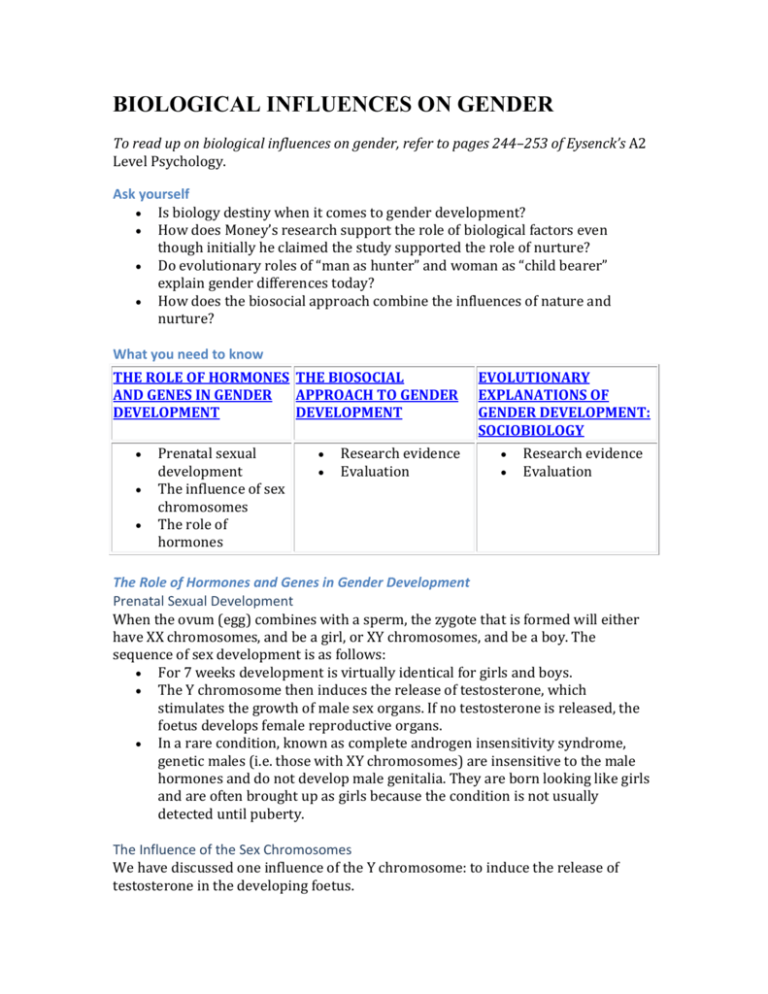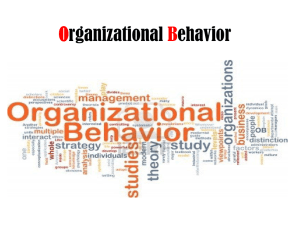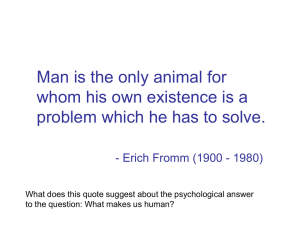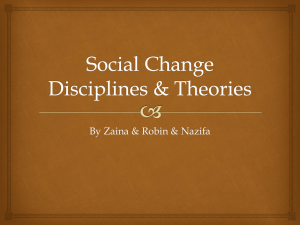BIOLOGICAL INFLUENCES ON GENDER
advertisement

BIOLOGICAL INFLUENCES ON GENDER To read up on biological influences on gender, refer to pages 244–253 of Eysenck’s A2 Level Psychology. Ask yourself Is biology destiny when it comes to gender development? How does Money’s research support the role of biological factors even though initially he claimed the study supported the role of nurture? Do evolutionary roles of “man as hunter” and woman as “child bearer” explain gender differences today? How does the biosocial approach combine the influences of nature and nurture? What you need to know THE ROLE OF HORMONES THE BIOSOCIAL AND GENES IN GENDER APPROACH TO GENDER DEVELOPMENT DEVELOPMENT Prenatal sexual development The influence of sex chromosomes The role of hormones Research evidence Evaluation EVOLUTIONARY EXPLANATIONS OF GENDER DEVELOPMENT: SOCIOBIOLOGY Research evidence Evaluation The Role of Hormones and Genes in Gender Development Prenatal Sexual Development When the ovum (egg) combines with a sperm, the zygote that is formed will either have XX chromosomes, and be a girl, or XY chromosomes, and be a boy. The sequence of sex development is as follows: For 7 weeks development is virtually identical for girls and boys. The Y chromosome then induces the release of testosterone, which stimulates the growth of male sex organs. If no testosterone is released, the foetus develops female reproductive organs. In a rare condition, known as complete androgen insensitivity syndrome, genetic males (i.e. those with XY chromosomes) are insensitive to the male hormones and do not develop male genitalia. They are born looking like girls and are often brought up as girls because the condition is not usually detected until puberty. The Influence of the Sex Chromosomes We have discussed one influence of the Y chromosome: to induce the release of testosterone in the developing foetus. The Y chromosome is one fifth of its size, hence boys carry less genetic material than girls, and this may be one reason why males are more vulnerable than females throughout their lives. Montagu (1968, see A2 Level Psychology page 245) listed 62 specific disorders that are largely or wholly due to sex-linked genes and found mostly in males, including some very serious ones, such as haemophilia, as well as less important ones such as red/green colour-blindness. The Role of Hormones The role of hormones in sexual development is of enormous importance. Each sex has identical sex hormones; the difference between them is the amount they produce. Within normal biological development, females produce a preponderance of female sex hormones (oestrogen and progesterone), whilst males produce a preponderance of androgens (a collection of male hormones) of which one of the most important is testosterone. Up to about the age of 8–10, negligible amounts of sex hormones are produced by either sex but after that both sexes produce more male and female hormones. From around 11 years of age, both girls and boys increase their production of female hormones but females produce far more than boys. Conversely, once children reach puberty both sexes increases their production of male sex hormones rapidly but boys more so than girls. RESEARCH EVIDENCE Young, Goy, and Phoenix (1964, see A2 Level Psychology page 246) demonstrated that pregnant monkeys injected with androgens have given birth to females with masculinised genitalia and who act in masculine ways, such as being threatening and aggressive, engaging in rough-and-tumble play, and mounting females. Knickmeyer et al. (2005, see A2 Level Psychology page 246) studied the fT levels of in the amniotic fluid (the fluid around the baby in the uterus) of 35 male and 23 female babies. In animals, foetal testosterone (fT) plays a central role in organising the brain and in later social behaviour. In humans it has been linked negatively with language development and eye-contact, and positively with spatial ability. Based on their mothers’ assessment of their language skills, quality of social relationships, and restricted interests at aged 4, the researchers found a negative correlation between fT and the quality of social relationships and a positive correlation between fT and restricted interests in the boys. This indicates that testosterone may negatively affect social relationships. Dalton (1969, see A2 Level Psychology page 246) summarised research on the effect of sex hormones on the menstrual cycle. Sex hormones have been linked to pre-menstrual syndrome, which occurs when progesterone levels are low. Pre-menstrual syndrome/tension tends to be a catchall phrase for a variety of symptoms, including depression and irritability. Dalton reported that many studies showed behaviour change that could be attributed to the menstrual cycle. 63% to 84% of crimes committed by women occur in the pre-menstrual period. Accident and suicide rates increase, while there is a decline in the standard of schoolwork, in scores on intelligence tests, and in speed of response. Mcfarlane, Martin, and Williams (1988, see A2 Level Psychology page 247) report different findings. They, and others, maintain that although a small percentage of women do suffer relatively intense periodic mood swings related to their menstrual cycle, in most women there is little relationship between the menstrual cycle and mood. They point out that there may be a self-fulfilling prophecy operating—women expecting to feel moody and depressed at this time of the month may make this more likely, and may make them more aware of clumsiness, etc. than at other times of their menstrual cycle. Collaer and Hines (1995, see A2 Level Psychology page 247) reviewed the somewhat inconsistent findings from numerous studies of the effect of sex hormones on behaviour. They argued that there is good evidence for at least three effects. o First, male sex hormones increase the likelihood that the child will enjoy rough-and-tumble play and physical activity generally. o Second, exposure to high levels of male sex hormones at an early age affects sexual orientation in adolescence. o Third, male sex hormones lead to an increase in aggressive behaviour. The Biosocial Approach to Gender Development The biosocial approach to gender development emphasises that it is the interaction of both nature and nurture that is important rather than one or the other. The theory fully acknowledges the importance of biology so it would involve all the biological research just covered, but it also acknowledges that social factors may interact with these to influence gender identity. Biosocial theory was first advanced by Money and Ehrhardt (1972, see A2 Level Psychology page 247) who start by proposing that there are a number of critical events that affect the early development of the child. These events begin before birth with the biological influences covered in the previous section. These biological factors obviously have a large influence on the child. However, from birth onwards, social factors also begin to play an important part. As we have already seen, once a child is labelled as a boy or girl they are treated very differently, and these social factors interact with the biological ones to determine the child’s gender identity. In the majority of cases, the child’s biological sex matches the gender of upbringing and there are no problems. However, some individuals, known as intersex children, are born with ambiguous genitals and are not obviously one sex or the other. Money believes that provided a child’s sex of rearing is decided before their third birthday, then social factors are so strongly influential that such children will accept their assigned gender identity. The third year is another critical period and since a child’s gender identity is established by that age, then, according to Money, it cannot thereafter be changed without causing the child serious psychological problems. Research evidence Goldwyn (1979, see A2 Level Psychology page 248) cites the case of Mrs DW who had androgen insensitivity syndrome and was brought up as a woman. Although informed in her teens, at no time did she ever feel masculine and was completely happy with her eventual role as wife and adoptive mother. This, of course, is a case study of one, which makes it hard to draw firm conclusions. It also isn’t entirely clear whether we can say that Mrs DW was influenced by social factors (reared as a girl) or biological ones (exposure to male hormones). Imperato-McGinley et al. (1974, see A2 Level Psychology page 249) described a family in the Dominican Republic, a case that contradicts the theory. Four of the sons appeared biologically to be female when they were born and they were reared as girls. However, at the age of about 12, they developed male genitals and started to look like ordinary adolescent males. In spite of the fact that all four of them had been reared as girls, and had thought of themselves as females, they seemed to adjust well to the male role. Nevertheless, it is still difficult to draw firm conclusions as the male role is more respected in this community than is the female one, so their acceptance of a changed gender identity could have been influenced by social factors as well as biological ones. Colapinto (2000, see A2 Level Psychology page 248) reports the case of David Reimer, which does not support the biosocial approach. Reimer was raised as a girl after his penis was accidentally burnt off during a botched operation at 8 months. According to Money (1975), this was a success but the “girl” was never happy as a girl and once the truth was revealed to her, she reverted to being a male. EVALUATION Support from research evidence. There is a considerable body of evidence to indicate that biosocial theory, with its emphasis on the interaction of biological and social factors, has a lot to recommend it. Several case studies, such as that of Mrs DW, demonstrate that it is quite possible to be content with the gender identity of upbringing even when it clashes with that of the chromosomal sex. Lack of support in specific aspects of the theory. The more specific assertion of Money and Ehrhardt (1972) that in the first two-and-a-half to three years a child’s sense of itself is flexible enough to allow its sexual label to be changed without undue disturbance is now somewhat discredited, especially in light of the Reimer case. Contradictory evidence from research. Findings from other studies are in fairly direct conflict between biological and social factors. For example, the case of the four children in the family from the Dominican Republic seems to show that biological factors cannot always be outweighed by social factors. Evolutionary Explanations of Gender Roles: Sociobiology Sociobiology applies the principles of evolution to the understanding of social behaviour. The theory argues that the behaviour of all animals has evolved so that it maximises the likelihood that individuals will pass on their genes to future generations. In human terms, this means that both women and men unconsciously behave in ways that promote conception, birth, and survival of their offspring. In pursuit of this end, the optimal mating behaviour differs dramatically between men and women (Trivers, 1972, see A2 Level Psychology page 249). Since a man can, in theory, impregnate many women within a short time and will only waste some easily replaceable sperm if sexual intercourse does not result in pregnancy, it is in his interest to be promiscuous and seek out good child-bearers. A woman, who has to invest a great deal more in bearing each child than does a man, is likely to be far more choosy when selecting a mate. She will be coy, take her time, and choose a man who can provide for her and her infant, perhaps an older man who is established in his career. RESEARCH EVIDENCE Buss (1989, see A2 Level Psychology page 250), in an extensive study of 37 cultures (in 33 countries), analysed the results of more than 10,000 questionnaires asking respondents to rate a number of factors such as age, intelligence, and sociability for their importance in a sexual partner. Consistent with sociobiological theory, men valued physical attractiveness more than did women, while women were more likely than men to value good earning potential and high occupational status. In all the cultures both women and men preferred the man to be the older of the pair. It is worth noting however that gender differences in the importance of physical attraction are stronger when people estimate its importance (as in questionnaires) than when they actually interact with someone. Williams and Best (1982, see A2 Level Psychology page 250) explored gender stereotypes in 30 different national cultures. They found that there were many similarities across the various cultures. Men were seen as more dominant, aggressive, and autonomous, in a more instrumental role. Whereas women were more nurturant, deferent, and interested in affiliation, being encouraged to develop an expressive role. This finding was also supported by Barry, Bacon, and Child (1957). Mead (1935, see A2 Level Psychology page 250) generally hypothesised that gender differences are cultural. Nevertheless, within each cultural group studied by Mead the males were generally more aggressive than the women. Even in the Tchambuli, in which gender roles showed some reversal from the usual patterns, it was the men not the women who did most of the fighting in times of war. This supports the idea of inherited gender-role behaviours. Davis (1990, see A2 Level Psychology page 250) conducted research on “personal” advertisements. This indicated that there are consistent differences in what men and women desire in a sexual partner. Consistent with sociobiological theory, this analysis found that men tended to emphasise their wealth or other resources while looking for women younger than themselves. In contrast, women indicated that they were looking for a high-status, wealthy man, and mentioned their own physical attractiveness. Nevertheless, physical characteristics were the most desired attributes for both men and women. Singh (1993) found that men are attracted to women with a low waist-to-hip ratio (with the waist smaller than the hip!) and this is related to childbearing potential. EVALUATION Support from cross-cultural studies. Most cross-cultural studies have indicated that the cultural expectations and stereotypes for boys and girls are surprisingly similar in otherwise very different cultures. Contradictions from cross-cultural studies. However, it is important to look in more detail at some of the findings. In the study by Buss (1989) there were some significant findings that have received far less attention. Both men and women placed exactly the same four attributes highest on their preference list—mutual attraction, dependable character, emotional stability and maturity, and pleasing disposition. Their rankings of qualities also placed the same four items on top—kind and understanding, intelligent, exciting, and healthy (Smith & Bond, 1993, see A2 Level Psychology page 251). So the support for the sociobiological view that there are large and significant differences in the attributes universally sought by males and females is not entirely convincing. Studies do not offer complete support. Williams and Best (1982) also do not offer unequivocal support. They found that the consensus of what women and men find desirable was true in collectivistic societies but weaker in individualistic societies where gender equality is more influential. This suggests that socialisation practices as well as biology can influence the characteristics men and women find desirable. Problems with the actual theory. The major limitation of sociobiological explanations in general is that they use hindsight to explain almost any behaviour in terms of why it has evolved. The reasoning is post hoc (after the event) and it is possible to argue that almost any observed gender differences are due to evolution. Lack of empirical evidence. The hypotheses suggested by the sociobiologists often have no empirical evidence to support them, they are merely conjecture (sometimes referred to as stories). No predictive power, so not a scientific theory. One important characteristic of a good theory is that it can be used to make predictions about the future. However, sociobiology has little predictive value. There are so many possibilities with regard to how behaviour may evolve that prediction becomes impossible. Difficult to untangle the effects of culture from those of evolution. Despite Buss’ work, there are significant historical and cultural differences in heterosexual mate selection. For example, men’s preference for younger women was considerably greater in the past than it is now and is greater in traditional than in modern societies (Glenn, 1989, see A2 Level Psychology page 252). The difficulty of separating culture from evolution will always mean that sociobiology is likely to remain controversial. Problem with the argument that certain patterns of behaviour are “hard wired” by evolution and cannot easily be influenced by other factors. When we look more closely at both human and non-human animal behaviour concerning sex and infant care, we find a huge variety of behaviours within a single species, and changes in environment can have a profound effect on this behaviour. Even species of birds change their mating behaviour quite drastically according to the availability of good nesting sites and food sources, so it would be very surprising if humans were less adaptable. Having plasticity of behaviour rather than rigidly determined invariant patterns can have a great survival value (Fausto-Sterling, 2000, see A2 Level Psychology page 252). So What Does This Mean? So is biology destiny? There is no doubt that there are important biological influences on our behaviour, as illustrated so poignantly by the case of David Reimer. In addition, evolution is certain to have shaped some of our behaviour, just as surely as it has shaped our bodies. Nevertheless, it would seem fair to say that however important biological factors are, they can only provide a partial explanation for the development of gender roles. We have already seen how important social and cognitive factors, including the self-fulfilling prophecy, are in shaping behaviour. In the next section we will look at other influences before we try to draw tentative conclusions about the extent to which biology is destiny. Over To You 1(a). Outline the role of hormones and genes in gender development. (10 marks) 1(b). Evaluate the evolutionary explanation of gender roles. (15 marks)








